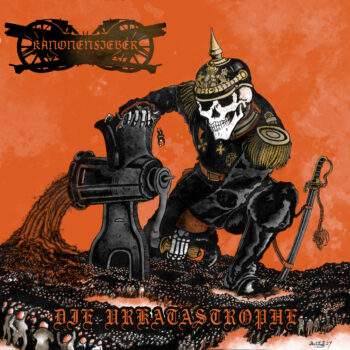When I wrote up Menschenmühle, the debut full-length by Germany’s Kanonenfieber, in late 2021, I described it as “stunning.” The storytelling arc that it achieves, opening with the almost enthusiastic bombast of the early days of the Great War, through to the exhausted horror of No Man’s Land, is incredible. Cast in shades of blackened death metal, I ended up crowning it my Album of the Year, calling it a “masterpiece.” So how does one write the follow-up to a masterpiece? When I sat down with anonymous Kanonenfieber mastermind1 Noise in 2023, I asked. He admitted to “having some struggles […] I don’t know, I’ve written the album four times over now but somehow, I just don’t like any of it.” Scroll forward a year and I finally got my sweaty little fanboy fins on Die Urkatastrophe. Did Noise get through his struggles to produce a worthy successor to Menschenmühle?
Like its predecessor, Die Urkatastrophe (which translates as something like “The Original Disaster”) focuses on the tragedies of the Great War, taking its inspiration from reports, letters, and other documents created by the soldiers who fought in that conflagration. It is uncompromising and brutal. Whether it’s the tale of the suicidal member of a mining team, tunneling under the front (“Der Maulwurf”)2 or the grinding battle that saw Austria-Hungary retake Lviv / Lemberg from the Russians (“Lviv zu Lemberg”), there’s an almost frantic energy to Kanonenfieber that is both vicious and beautiful. Simultaneously heavier and more melodic than what went before, Die Urkatastrophe flits between taking in the whole, awful scale of the War, panning across its fronts (“Gott mit der Kavallerie”), while at others zooming in on specific horrors (“Verdun” and its counterpart “Ausblutungsschlacht” ).
Die Urkatastrophe by Kanonenfieber
Kanonenfieber has developed an immediately identifiable sound and sense of individuality that sets it apart from the many reference points I could cite. Sure, the likes of Bolt Thrower and 1914 still feature strongly in Kanonenfieber’s work but Die Urkatastrophe is much more diverse. A blackened thrash edge creeps into Skeletonwitch territory in places (“Gott mit der Kavallerie”), while “Panzerhenker” and “Waffenbrüder” (the latter featuring Maik Weichert of Heaven Shall Burn) draw Kvaen into the mix. The infectiously catchy “Ritter der Lüfte” evokes Panzerfaust. While all those references and more are valid, the truth is that from Noise’s razorwire rasps and snarling growls—now expanded to include funeral doom-esque roars (“Panzerhenker”)—to his crystalline tremolos and killer death riffs, Kanonenfieber is now a touchstone in its own right. Part of what makes that true, and what distinguished Menschenmühle, is the skillful incorporation of samples and original recordings. These give Kanonenfieber the weight of authenticity, which is taken to the next level on Die Urkatastrophe. The threads of its stories of bloodshed, death, and despair are tied together by perfectly integrated battlefield effects and spoken word pieces, which feel organic and an integral—even essential—part of the whole. The tension built into opener “Grossmachtfantasie,” as the first rumbling riffs rise beneath a crackling recording is enough to give me goosebumps.
Noise’s vocal performance, already a selling point previously, is the strongest he’s ever given. This is amplified by the multi-tracking deployed across the record, as well as adornments, like the choral backing vocals on “Ausblutungsschlacht,” giving its ending an appropriately grand, symphonic feeling, as it details the slaughter at Verdun. As ever, the production is fantastic, although on this occasion Noise had assistance from Kristin Kohle of Kohlekeller Studio. The stellar guitar tone is hard to put into words. Whether it is the tremolo assault of “Menschenmühle” or the gorgeous percussion-free lament two-thirds of the way into “Lviv zu Lemberg” (recalling “Die Schlacht bei Tannenberg” from the previous album), the sound is organic and effortless, like a blackened Opeth in their heyday. The bass is also much more prominent in the mix, which is welcome, adding richness to the sound. My single critical comment is that Kanonenfieber tried to repeat a trick from the last album, ending with an acoustic semi-ballad. However, for me at least, Noise comes up very slightly short here. “Verscharrt und Ungerühmt” from Menschenmühle was lightning in a bottle; it tore out my heart and stamped it into the blood-soaked mud. Here, “Als die Waffen kamen” is a good song in its own right but lightning rarely strikes twice.
Die Urkatastrophe is more than I dared hope for. I’ve had this thing for nearly two months and must have listened to it fifty-plus times. The sole flaw is that its closing track doesn’t quite match the magic of its debut counterpart. Everything else is at least as good, and often better, with “Der Maulwurf,” “Lviv zu Lemberg,” and “Waffenbrüder” forming among the strongest three-track runs I’ve ever heard. The textures Kanonenfieber weaves into the sound, coupled with the subtle tempo and stylistic shifts, give this album an almost languid fluidity and make it a heart-wrenching joy to listen to. The skill and attention to detail that went into crafting this record are outstanding, while the one-man performances by Noise are phenomenal. What makes this record truly iconic, however, is the storytelling and Noise’s ability to tailor his chosen sound to each horror he is conveying, be it the insanity of the war as a whole (“Menschenmühle”), suicidal desperation (“Der Maulwurf”) or otherwise.3
In a review of Non Est Deus, I said that I would, reluctantly, have to pass on the reviewing baton for Noise’s projects. I lied. Obviously.4
Rating: 5.0/5.0
DR: 7 | Format Reviewed: 256 kbps mp3
Label: Century Media Records
Websites: noisebringer-records.bandcamp.com | noisebringer.de | facebook.com/Kanonenfieber
Releases Worldwide: September 20th, 2024
The post Kanonenfieber – Die Urkatastrophe Review appeared first on Angry Metal Guy.



